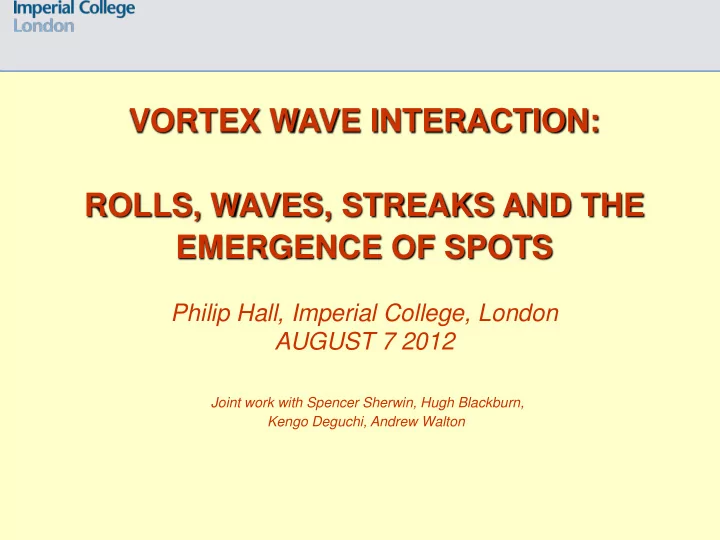

VORTEX WAVE INTERACTION: ROLLS, WAVES, STREAKS AND THE EMERGENCE OF SPOTS Philip Hall, Imperial College, London AUGUST 7 2012 Joint work with Spencer Sherwin, Hugh Blackburn, Kengo Deguchi, Andrew Walton
Turbulent boundary layer • • Kline, Reynolds, Schraub & Runstadler, JFM 1967
• NUMERICAL SIMULATIONS OF PPF • Kim, Moin & Moser, JFM 1987, R 180, Rm 5600
Self Sustained processes: Waleffe, Nagata, Kim, Eckhardt, … Numerical simulations of turbulent flow Regularly visit equilibrium structures
VORTEX WAVE INTERACTIONS,SELF SUSTAINED PROCESSES ,EXACT COHERENT STRUCTURES: WHATS THE DIFFERENCE? D.J. Benney The evolution of disturbances in shear flows at high Reynolds numbers, Stud. Appl. Math. 70, 1-19 (1984). Hall, P., Smith, F.T. Vortex-wave interaction theory, formal high R description of rolls, waves and streaks interacting.1987,1988,1991 Nagata. M. Finite R finite amplitude numerical equilibrium solutions of Plane Couette flow.…1990. Followed by Waleffe, Kerswell, Eckhardt , …… pipes and channels. Numerical results show equilibrium structures with rolls driving streaks which are themselves unstable to waves which drive the rolls and so on ……. “ Self sustained processes ”
Nonlinear equilibrium states- Wang, Gibson, Waleffe 2007 WALEFFE REALIZED CRITICAL LAYER STRUCTURE PRESENT BUT…..
EDGE STATES: LOWER BRANCH SSP, Eckhardt, Schneider, Kerswell,...... Take initial disturbance of given size and march Navier Stokes equations forward in time. Adjust initial size so solution stays between ‘laminar’ and ‘turbulent state as long as possible- defines an edge state. Numerically find edge states are lower branch self sustained processes.
EDGE STATE CONVERGES TO LOWER BRANCH EQUILIBRIUM STATE
LIMITATIONS OF FULL NUMERICAL APPROACH For R increasing small scale structures develop and cannot find equilibrium states- limited to R<20K. Calculations very expensive, few solutions known. Physics has to be interpreted from numerical data Solutions hard to find, upper branch not understood, possibly only lower branch solutions at high R. BUT lower branch play role of ‘gatekeeper’ between laminar and turbulent attractors and DNS simulations of turbulence regularly visit equilibrium. Localized solutions found , similar to turbulent spots found in full DNS simulaitons.
VORTEX WAVE INTERACTION THEORY • USE large R assumption so necessarily no difficulty reaching high R, and shows why numerical approach will always fail. • VWI -Vortex wave interaction theory – VWI. Hall-Smith 89,90,91,92. • Wave system and longitudinal vortex structure strongly coupled and evolve in time and/or space. VWI suggests wave interaction applied to Couette flow~ 1/R^(5/6). Effect of wave on roll calcualted analytically based on large R, gives jump conditions for roll flow across critical layer.
Vortex wave interaction theory Hall-Smith 1988- Longitudinal vortices driven in critical layer or wall layer locally neutrally stable TS or Rayleigh waves Locally neutral driving vortex in critical or wall layer Spanwise view of critical layer
Now following Hall-Smith (1991) expand flow in terms of a roll, streak, and wave with wave size fixed in order to drive the roll flow, roll flow decoupled from streak flow and driven by wave Reynolds stresses, roll drives streak then wave lives as instability of streak
VORTEX WAVE INTERACTION EQUATIONS Nonlinear eigenvalue Problem for rho in terms of alpha and spanwise wavenumber So SSP (Waleffe, Kerswell, Eckhardt….from mid 2001… =finite Reynolds number version of VWI
UPPER LIMIT OF WAVENUMBER FOR EQUILIBRIUM STATES Finite amplitude solutions in long wave limit • Each point on curve generates a familiy of • solutions over a range of Reynolds numbers • and small scale structure has been taken out
Variation of drag with wavenumber Minimum drag at zero wavenumber! Actually not quite zero new problem emerges At alpha~1/R, critical layer now fills channel, also upper limit for alpha for existence of nonlinear solution, correlates well with minimum box size for sustained turbulence
Comparison with Wang, Gibson, Waleffe VWI u-y (streak) Slope =.91 from DNS, VWI Predicts slope=11/12 W_1(wave) (v,w), (roll)
Effect of spanwise wavenumber So small spanwise limit gives structures independent of walls and gives new canonical state applicable to ANY shear flow. And satisfies Kolmogorov 5/3 scaling!! And generalizes to basic flows u(y,z), so can do Hagen-Poisseuille flow
SMALL WAVELENGTH LIMIT, MINIMUM DRAG CONFIGURATION Theory shows minimum drag occurs when alpha tends to zero, in fact new regime develops when alpha ~ 1/R, critical layer then fills whole channel and all harmonics in streamwise direction matter. (Deguchi, Hall, Walton 2012) i.e. just the NONLINEAR GORTLER VORTEX EQUATIONS OF HALL 1988 with G=0
Nonlinear Equilibrium states for long waves
EQUILIBRIUM STATES
DEVELOPMENT OF SPOTS- locally in x for fixed beta, then x and x as beta decreases
DEVELOPMENT OF SPOTS- locally in x for fixed beta, then x and x as beta decreases
DEVELOPMENT OF SPOTS- locally in x for fixed beta, then x and z as beta decreases
MEAN FLOW CORRECTION Mean flow identical to full NS simulations of turbulence by Kamiano,Lundbladh et al 2001 and others- right hand curve shows mean flow distortion/beta ----- DNS calculations of Lundbladh
CONCLUSION VWI captures lower branch equilibrium states basically for all R, so edge state known precisely. Extends to arbitrary shear flows to give new class of equilibrium states, satisfies Kolmogorov 5/3 law. Upper limit of streamwise wavenumber correlates with minimum box size for sustained turbulence in a box. Long wave limit predicts minimum box size ~R/10 needed for turbulent spots to develop Key is using high R asymptotics ot calcualte detailed structure leaving CFD applied to small system with no small scale structure. Long wavelength limit gives remarkable prediction of turbulent mean flow- means large scale structures fix mean state, can allow for small scale structures
Recommend
More recommend